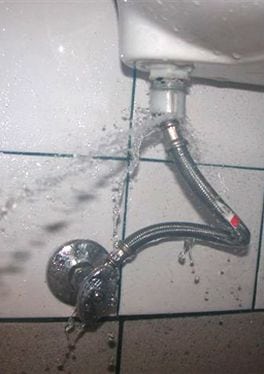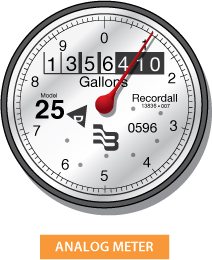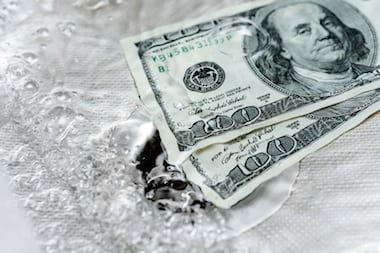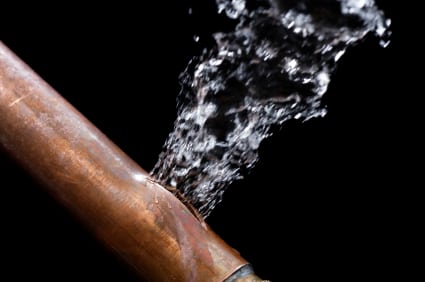March 18, 2019
When your home is faced with water damage, it is easy to become overwhelmed. Your initial stress will probably result from the fact that your pipe just burst and your basement is flooding, or that your faucet has been leaking for weeks without your knowledge and you can’t possibly wrap your head around how you didn’t notice. After that initial stress sinks in, further stress arrives around damage control, as you scramble around your house trying to reduce the harm currently being done to your home. While a million different thoughts are running around in your head, it can be difficult to focus on what you should be doing. In order to know what you should be doing, it is important to identify what type of water leak you have.
Assess What Type of Water Leak You Have
Non-Damaging — But Costly
These types of leaks, while inconvenient, do not cause much significant damage to your home. Instead of costing you damage to your home, they will most likely cost you more time, energy, and money to resolve. Consider the last time you saw a sprinkler spouting straight up into the air as opposed to watering the grass or the last time you went into your bathroom to hear the toilet running even though it hadn’t been used recently.

Minimal Damage — But Will Worsen Over Time
Minimal damage leaks may not look like a huge issue at first, but if left unattended to, will result in more significant damage in the future. These leaks often go unnoticed, such as a leak in your wall, a leak in a faucet or shower, or a drip from an appliance. Occasionally, these leaks occur in more dangerous areas of your home, such as in a boiler or a hot water heater.
Significant Damage — Home is Being Destroyed — Act Now
Hopefully, a leak in your home never falls into this category, as these leaks can cause a great deal of harm upon your home. Significant damage leaks are fairly easy to identify, as your home is most likely being flooded with water. Leaks such as burst and frozen pipes have the potential to result in this type of leak that requires immediate attention.
Non-Damaging Water Leaks — What to Do
- Turn Off All Faucets, Showers, and Hoses – Shut off all sources of water so that you can determine if there is an issue with the water supply in your home. If water is still running around the house, it could complicate your efforts to locate the source of the leak.
- Check Your Water Meter – After all water sources are shut down, check if your water is still running. You can do this by locating the low-flow indicator on your water meter. Typically, the low-flow indicator is in the shape of a small triangle, star or gear. For more on how to read your water meter, please visit http://www.smarthomewaterguide.org/how-to-read-your-water-meter. If the low-flow indicator is still spinning, that means that water is still running and you can confirm that you have a leak.
- Shut Down Your Toilets – The most common culprit of non-damaging water leaks in your toilet. Try shutting down your toilets, one at a time, and checking your low-flow indicator after every shutdown. If the low-flow indicator stops spinning after you shut down a toilet, you have found your leak. If it continues to spin, try shutting down another toilet until the low-flow indicator stops spinning.
- Shut Down Other Appliances One by One – If shutting down all of your toilets does not result in a static low-flow indicator, it means that your leak is coming from somewhere else. In order to find the leak, you can either shut down appliances one by one and continuously check the low-flow indicator, or you can simply call a plumber to identify the leak. For more on identifying the source of a leak, check out our blog: Detect and Chase Down Leaks with the 10-Minute WaterSense Challenge.
Minimal Damage Water Leaks — What to Do

- Turn Off Water in Home – It is important to locate your water meter and turn off the water in your home before the leak results in more damage.
- Clean Up Mess – If you catch the leak early enough, it is important to clean up the mess immediately. Failure to clean up a water leak can result in mold and mildew and present more problems down the road. For this reason, it is important to disinfect anything the water has touched. Be sure to be conscientious of what you are touching, and wear protective clothing such as gloves, boots, dust, and eye masks if possible.
- Fix Issue that Resulted in Leak – If the leak cannot be fixed on your own, call a plumber to resolve the issue as soon as possible.
Significant Damage Water Leaks — Home is Being Destroyed — Act Now
- Turn Off Water in Home – Locate your water meter and turn off the water to prevent any more flooding than what has already occurred. If you cannot turn off the water by yourself, contact a plumber immediately to help you turn it off.
- Document Damage – Document the damage the water has done to your home. If possible, try to take photos and/or videos of the damage before you undertake any clean-up efforts.
- Call Insurance Company – It is important to notify your insurance company within a reasonable amount of time after the leak so that they are aware of the issue and can take action to help you.
 Identify Source of Damage – Try and identify the source of the leak yourself, if possible. However, if you are unable to identify the source of the leak, you may need to call a plumber.
Identify Source of Damage – Try and identify the source of the leak yourself, if possible. However, if you are unable to identify the source of the leak, you may need to call a plumber.- Fix Issue that Caused Leak – If unable to fix yourself, a plumber may need to be called.
- Remediate Other Issues – It may be necessary to call a contractor to help eliminate mold and mildew or to repair damaged drywall. However, do not make permanent repairs before you have approval from your insurance company! If you do not wait for approval, you may not be compensated for repairs.
Contacting Your Insurance Company
- Review Insurance Policy – Ensure you have coverage for water damage in your insurance policy before reaching out to the insurance company.
- Record Important Information – It is important to keep a record of the following information:
- Date of water damage
- Location of water damage
- Contact information of property owner
- Pictures and/or videos of water damage
- Detailed inventory of damaged possessions
- Cleanup and remediation estimates
- Talk to Insurance Company
Explain to the insurance company what happened, and be sure to keep a record of who you spoke to, what you spoke about, and when you spoke.
- Sit Tight – Do Not Make Any Changes – Most insurance companies will start investigating your claim within 15 days of receiving a written notice from you.
- Adjuster – The insurance company will send an adjuster to your home to inspect the damage. The fee is usually a percentage of the claim and is subtracted from the settlement you receive.
- Settle Claim and Remediate Damages – Be sure to keep all receipts for cleanup, repairs, and other related costs!
Clean Up
Pre-Cleanup
Make sure you have contacted the insurance company and they have assessed the damage before you perform significant cleanup! Be sure to wear rubber boots, rubber gloves, dust, and eye masks to minimize your chances of injury or infection.
Turn Off Power
This is especially important if the flood is above the outlet line. You may need to call an electrician if the circuit breaker is out of reach.
Disinfect and Air Out
Disinfect anything that has been touched by standing water. Be sure to open windows and doors and run fans and dehumidifiers to help dry out the space.
Prevention
To avoid damaging or even non-damaging leaks, a leak detection and automatic shut-off system can provide alerts through your mobile device or computer when water use is irregular.
This article originally appeared on June 6, 2018, and is being reprinted with permission. From time to time, Water – Use It Wisely features guest bloggers who write about topics related to water and water conservation. The author of this blog post, Dan Sterling, is the founder and CEO of Water Hero. Water Hero manufactures an internet-connected, leak detection device to protect homes from wasteful water leaks that drive up your bills and damaging water leaks that can destroy a home.
Subscribe to our newsletter
Signup today for monthly updates.
Subscribe Today


 Identify Source of Damage –
Identify Source of Damage – 


 Identify Source of Damage –
Identify Source of Damage –